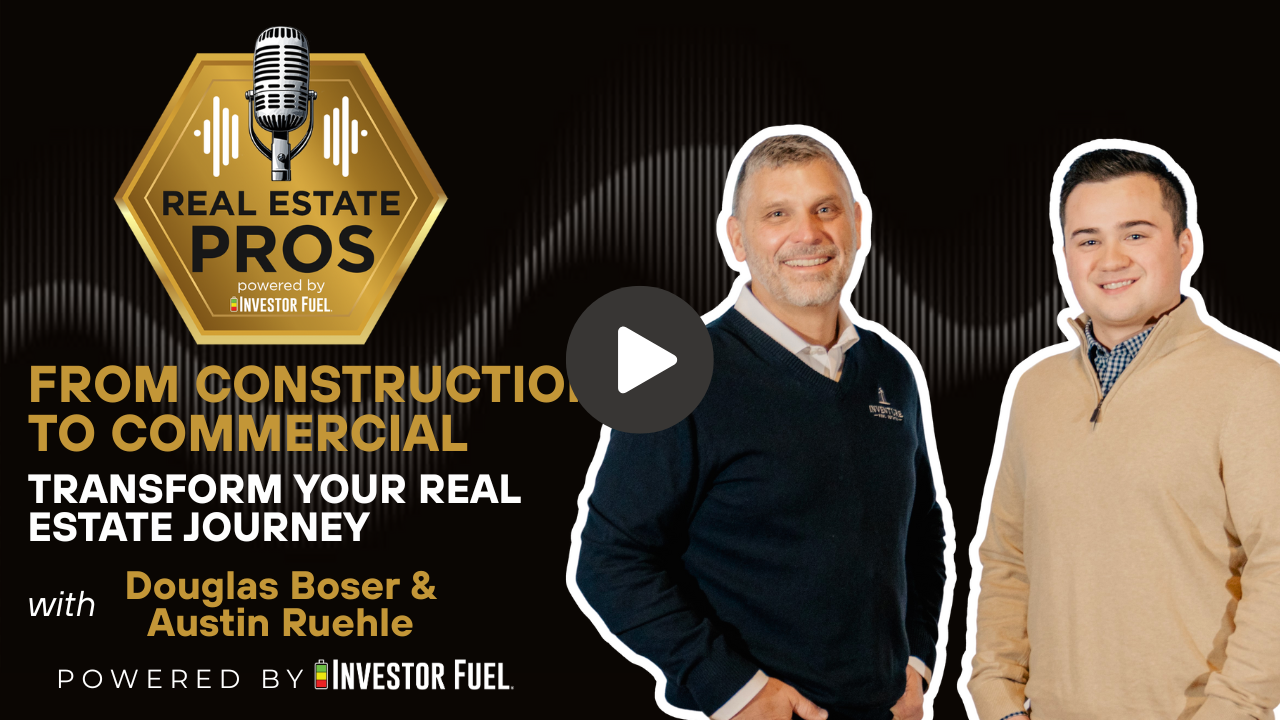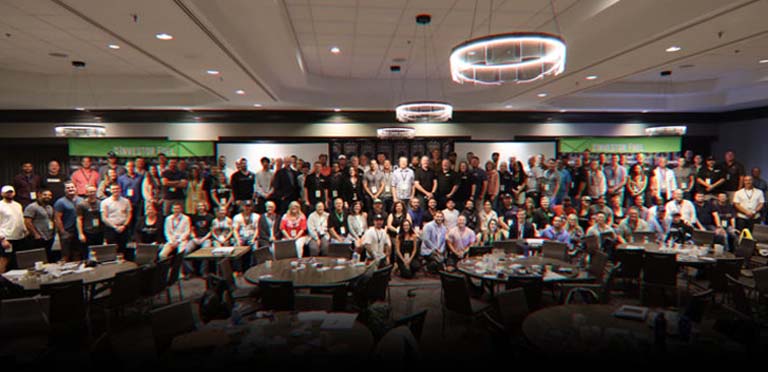
Show Summary
In this conversation, Dylan Silver hosts Doug Boser and Austin Ruehle, who share their journeys into the real estate industry, transitioning from construction to commercial real estate investment. They discuss the importance of networking, analyzing deals, and the significance of location and building quality. The conversation also touches on adapting to market changes, the future of commercial real estate, and the growing trend of flex spaces in various industries, including healthcare. Doug and Austin emphasize the importance of problem-solving and collaboration in real estate operations.
Resources and Links from this show:
Listen to the Audio Version of this Episode
Investor Fuel Show Transcript:
Dylan Silver (00:00.782)
Hey everybody, welcome back to the show. I’m your host, Dylan Silver. And today on the show, we have the CEO of Inventure Companies and the president of Inventure Companies. have Doug Boser and Austin Ruehle. Gentlemen, welcome to the show.
Douglas Boser (00:16.719)
Hey, thanks for having us, Dylan.
Austin Ruehle (00:18.39)
Yes, thanks Dylan.
Dylan Silver (00:18.626)
Absolutely, absolutely. You know, I think it’s a little cold in Texas, but I’m not in Minnesota. So is it freezing over there right now?
Douglas Boser (00:26.635)
You know, we just had a big snowstorm last week and things are starting to melt off a little bit. So yeah, I’m guessing we’re we’re in a little bit worse situation than you are.
Austin Ruehle (00:36.612)
Your cold is a little different.
Dylan Silver (00:36.76)
We have tornadoes over here. I didn’t know before I moved here in September of last year that there would be tornadoes, but I’m certainly glad that I’m not shoveling out my driveway. But I always like to start off at the top with how folks got into the real estate space initially. Was it in your blood? Was it divine intervention?
Douglas Boser (00:47.295)
Yeah.
Douglas Boser (00:57.184)
No, I’ll, I’ll, I’ll lead out here. So I’ve been in construction and real estate since 1989 now. So I, I’ve got a few more years on the both of you. Um, but mine was about a love of business. You know, I grew up on a farm North of here a little bit and construction was in my blood. So I just started off early on at the age of 14. I was actually building cabinets already at my parents’ farm. And, uh, at 17 built my first house professionally. And so I knew that kind of that construction was.
something I wanted to have, like I really wanted to chase my passion. Went to school to actually become a carpenter at the vocational school over in Alexandria. And then at 21 came back to the big town, we call it of St. Cloud and really started to kind of figure out who and what I wanted to work with. And so at 25, I basically started my own construction company, just
set off on my own kind of path and said, you know what I can I can do better or do differently than what my former boss was giving me the opportunities to do. So with that was really a bunch of growth throughout the time that I was running the construction company and then 2017 actually sold that construction company after 21 years in the business. And that was really to follow my real estate passion, which is what kind of we’ll talk about today a little bit deeper. But that
That real estate passion was something that just throughout time, we started building buildings for people. Clients would come to us and ask us like, hey, could you build this building? And we’re like, well, yeah, we could build it. And then they’re like, well, could you own it? I’m like, you know, we probably could figure that out. And so it was just kind of, kind of by happenstance that we actually got into the real estate side a lot more. But when we transitioned the construction company over to two of the employees, it really gave me the opportunity to.
springboard into real estate full-time. And will talk a little bit about his journey as well.
Dylan Silver (02:56.035)
Wow.
Austin Ruehle (03:01.903)
Yeah, mine really started while I was going to school. So I was going to the, going to St. Cloud State up here, University of State School in St. Cloud and really had a plan to get into financial or wealth management.
because when you’re going into school they don’t really tell you about commercial real estate or that there’s even really a career within that sector.
shortly after getting there, understanding after taking a few classes and talking to a few teachers that commercial real estate was something that you could do. And really one of my goals was to actually own real estate at some point and to invest. So when I figured out I could kind of marry those two things right away, that’s really how I got into it. So I switched my major, got into commercial real estate. Yeah, still don’t.
Dylan Silver (03:52.3)
No, no, no, I cut you off. That was my bad. Go ahead.
Douglas Boser (03:53.855)
You
Austin Ruehle (03:54.672)
No, you’re good. You’re good. So got into it and as I continued through, I was getting close to graduating and knew I wanted to stay in St. Cloud and kind of work in the commercial real estate sector. Doug at that point was looking for an associate really to kind of help him.
start to grow the more portfolio side of our business after he had sold a construction company. So really that’s how I got into it. I got into it by going through school and realizing there’s a career in commercial real estate and the rest is kind of in history.
Dylan Silver (04:27.192)
I always tell folks that when you want to go into the real estate space, wherever you are in the country, the most important thing is fanatically networking, like guerrilla networking, you have to do whatever you have to do to get in the room. And sometimes that literally means paying to get in the room. This is kind of common. And in my experience, I was selling cars working for Nissan, had nobody in my family who
was in the real estate space or or a tangent space didn’t have financial advisors didn’t have mortgage brokers nothing right and I just knew I wanted to stop working 12 hour days and I felt like I was smart enough to go do this and so I said let me let me try my hand on it and ended up becoming a wholesaler got my real estate license and here we are today with a couple podcasts and living in DFW. Now when I think about the path of a real estate investor I tend to see that I tend to see
Douglas Boser (05:12.954)
and I’m of of of the importance of of the importance of of of importance of of the importance of importance of importance importance importance importance importance importance importance of importance of importance of of of of of of of of
Dylan Silver (05:24.162)
Wholesaler, fix and flipper, maybe short term rental, long term, mid term, and then now note buyers and hard money lenders. Doug, you had a very interesting upbringing in the business, right? It was in your blood, but you went from construction to then commercial, it sounds like, and then realizing, hey, let me actually own these deals instead of just put them up.
Douglas Boser (05:50.496)
Yeah, you know, it’s a great great comment because you know, I never thought of myself as going into real estate, right that transition kind of just happened but what’s interesting about the way we operate today now is that that construction skill set and you
30 some years, almost 35 years in the construction industry, mainly all in commercial. You know, we can look at a building quickly as an investment anywhere in the United States, really, and be able to underwrite it from how is it built? What are the good things about the building? What are the bad attributes? And then what’s really, I would say, kind of our superpower is that Austin is super strong on the investment side, right? So when we bring those two things together, we can analyze a deal in literally
10, 15 minutes if we have the right information, but do it in a competency that a lot of others don’t have. They have to rely on their contractor. They have to go find somebody to hopefully give them some good information. I can look at that structure just with my skill sets and be able to say, you know what, we’re going to pass in this Austin. Or transversely, this might take more money from the tenant improvement side than this other building. So actually let’s go buy that building because it’ll be a better investment and ultimately a return.
Dylan Silver (07:05.197)
Doug, how often do you find that that is the case with commercial? I actually think you’re kind of rare in a sense where I don’t find most commercial real estate investors have hung steel themselves before. You come from hanging steel to now owning the land and the investment itself, whereas many other people are really on the outside looking in. do you feel like you have a unique perspective and really an advantage in some way?
Douglas Boser (07:33.447)
Yeah, I think it’s a huge advantage. You know, when we look at now, we develop raw land. So I even, you know, with Mike’s, you know, tons of projects that I’ve built over my life, I can look at it from a civil standpoint and go, where should the water go in this property? How high should we raise it? How low should we make it? What are the aspects that the building we’re just going to, you know, start building a hotel pretty soon up here?
in St. Cloud. And so when we look at that, you know, you just start looking at all the aspects of design. It’s also something that I pride myself on being able to deliver and I’m teaching Austin a lot about it too is good design. So we work with our tenants, we’re doing their layouts. So it’s an efficiency, but it’s also a cost efficiency when we look at, you know, when we build a $15 million deal workup, and we’re looking at going, how do we save 100,000, 200, half million dollars?
We can find those loopholes pretty quickly and we can call out the problems that might occur and add contingency to the financing if we need to so that we know we’re covered when it comes to that final deal. And Austin would attest to this, but know, 45 deals later, we’ve never gone over budget on one of our projects yet. We’ve come close, but we’ve never gone over budget yet. So when we propose a return for our investors and ourselves, that investment usually comes out.
a little bit better because there’s typically money left over in the project.
Dylan Silver (08:56.27)
Well, if you’re expanding outside of Minnesota, I can think of a couple Texas towns that need some people who to take over some jobs. Austin on the investment side and the analysis of it, you know, on a, it’s on a scale that I really can’t comprehend. And I speak from a great deal of ignorance, not just a good deal, because when I’m underwriting deals and when I’m looking at, you know, fix and flips or an assignable contract, which is a space that I come from,
Douglas Boser (09:00.629)
Hey, we’re all about it.
Dylan Silver (09:25.922)
You know, I tend to look at what what’s the age of the home? What’s the square footage? The the majors, you know, foundation, kitchen, master bathroom is the roof in good condition. It’s got a new HVAC, right? And that’s that’s my my purview of of expertise. But when you’re doing a commercial property, there’s so much that comes into play, including majorly the area itself. Right. And so talk a little bit, you know, about all that.
Douglas Boser (09:38.164)
Thank
Austin Ruehle (09:45.071)
Mm-hmm.
Austin Ruehle (09:52.174)
Mm-hmm.
Dylan Silver (09:55.628)
distilled, what are the major factors that you’re looking at when you’re analyzing these deals?
Austin Ruehle (10:00.495)
Yeah, I think the one thing with commercials, gets kind of this wrap of being really hard to underwrite or do it because everyone wants to make it really complicated, but it’s really not. You look at from a start, does the deal work from a financial model, right? How does your cashflow look? How are the tenants looking? Are the tenants current? Are some of the spaces vacant? Are they just paying rent but not actually in the space so they’re not going to be there in a few years?
So if the financial model works, which is the easiest one for everyone to look at, right? Cause everyone looks at it from a financial look and that’s really it. Does my lease payments pay my debt and do I make a return, right? That’s a simple thing to look at. Anyone can kind of do that. Really the part that we really take that step in is pretty much the exact same thing that you said with your residential side of where you sit, except just think of it with scale, right? When we go into properties, the financial piece is like, is one piece.
but it really comes down to the two others, which is location and just overall building envelope. So the overall building envelope will probably be the most important in our opinion for how we invest in real estate. And that’s really, you know, what does the mechanical systems look like? What does the roof look like? What kind of major improvements do we have from like an amenity standpoint, right? So is it an old office building that needs new chairs, new paint?
knew everything in the lower level to come up to today’s standards? Or has somebody else already done that piece of it and have already upgraded some of the main mechanical systems, like a chiller tower, a boiler, a roof? How does the parking lot look? Because those are like those main big costs that always come up to buy investors, because you don’t look at it, right? If you look at a deal, an underwriter deal, but you never see the property, you never look at the HVAC, you never get the property condition reports, those are those things that you just will never see.
and end up hurting you in the long run. Like that’s the one piece that you’ll be going through a deal and all of a sudden, here’s a $200,000 elevator modernization that you get hit with, right? These are all things that we see and we’ve had happen to us, so that’s what you learn from them, right? To come up with the best situation. But yes, the last one really being location. Location is so vitally important. And it’s not really location of like, is it on a corner? Because that’s what everyone looks at. But it’s more about what’s going on in the surrounding area, right? Okay, so I have a building on a corner.
Austin Ruehle (12:19.535)
whether it’s retail, office, industrial, medical, whatever it is, what’s the rest of the market look like in that sub-market? How is it performing, right? So do we, if our building’s full today, but I’m competing with a bunch of buildings around me that are maybe nicer, maybe a little bit better, and are pretty vacant, well that tells me as an investor that when my tenants go out for renewal, their brokers are gonna go negotiate with the other owners, and I’m gonna get a worse deal, right?
So how can you hedge those a little bit? You can never do it perfectly, but you always wanna try to be the nicer building in the market so the vacancies wanna come to you if you have any, or it’s really hard to compete against you to get your building up to the standard that we’re at, at the lease rates that we’re at on an ongoing basis. And that’s really the same across any asset class. So we kind of like to keep our investing really simple and really stupid simple.
Just cause that’s how we operate. That’s how we like to do it. And it really kind of comes down to the Doug’s background of the construction piece. Like we tie that in very intentionally with anything that we invest into. Cause if we can take care of it, we know how it operates. We should be okay. For 99 point percent of anything that happens, there’s always the 1 % that you never know though, of course.
Douglas Boser (13:36.022)
Okay.
Douglas Boser (13:41.518)
No.
Dylan Silver (13:41.528)
You know, to your point, Austin, there’s so much that can go into it, it can seem overwhelming, but really, this is truly an interesting conversation for me to have because I’ve spoken now with quite a number of commercial real estate investors and you would think that I would see more people who come from hang and steal, who come from building the buildings, but I have not yet seen that. And it makes me realize like, hmm, you know,
There is a whole other aspect of this which people may not be tapping into. So Doug, how often are you getting people who are reaching out to you to say, can you come join this project because we want someone with your level of expertise. And does that happen frequently?
Douglas Boser (14:28.151)
You know, it doesn’t happen frequently because we stay so busy with our own stuff, right?
But we do offer inside of our company what we call owner’s representative work. So we act as the owner’s rep for say like the local large medical hospital up here. We’re building a $22 million apartment complex for them now. We don’t do multifamily, but we’re working on their behalf as their fiduciary, hire the architect, hire the contractor, and then we manage the whole entire project.
with my fingerprints on the project the whole time. So we’re kind of the maestro of the orchestra. And basically the owner, the owner that we work for, we’re speaking like we were them, right? So we’re making the decisions and we’re saying, do this, don’t do that. We’re always clearing it with the owner itself, but it allows the owner to bring us in as professionals for a specific project and then go away when the project is built.
Dylan Silver (15:30.854)
Let’s talk about the commercial space in general. I think I’ve spoken with so many different people about the commercial space, going from COVID to pre-COVID to now. And I’m curious, being in the space, are you bullish on commercial in general?
Douglas Boser (15:48.331)
I’ll let Austin start.
Austin Ruehle (15:49.818)
Well, think obviously what’s going on in the stock market today on the 7th kind of shows real estate in general is maybe a little bit better of a bet in some cases, because you don’t ride the wave as much. But yeah, mean, we’re bullish today, and I think we’ll always be bullish in it, because people always need space. The kind of space they need changes with time, so you got to…
change how you invest and what you look at from a deal structure and how deals are made. But extremely bullish overall. mean, people don’t want to, people are going to have a harder time owning different assets. If manufacturing comes into the U.S. that’s going to increase more manufacturing needs, more industrial space that’s already been booming across the U.S. for quite some time now. And even office space, in my opinion, is always going to be pretty good. It just depends on what you’re investing in and where. Like your major metros are going to have a
time right. Like we’re in Minnesota and obviously Minneapolis downtown is terrible. It’s getting hit on all sides from everything. But you still have investors buying stuff. It’s just extremely cheap. So it’ll be interesting to see what they do with those products and how that changes over the next five to 10 years. But as things change in one.
Douglas Boser (17:01.922)
you
Austin Ruehle (17:02.687)
Sector and what some market it changes in the outside red. So like downtown Minneapolis is having a hard time So then the sub markets get really good around it So it’s just finding those different pockets and trying to be ahead of the curve a little bit to catch stuff as it’s going up Not when it’s going down, of course
Douglas Boser (17:17.321)
.
Dylan Silver (17:18.552)
You know, to your point, Austin, there is this kind of tendency for people to freak out and that to kind of be the overwhelming sentiment. You know, we saw that heavily during COVID, but I was speaking to a gentleman in New Jersey who was in this space and basically his business expanded because he went from one area to industrial investment, which I was ignorant to. You know, I was unaware that
this was booming during this time period. So of course, with everything that happened during that time period, people were ordering from home. So you needed warehouses and so on and so forth. And so he was buying those up and the tenants were there because they needed, they needed the space, right? You needed space for all these, these different products that people were getting from home. And so, you know, Doug, you, you’ve been a part of so many different sides of this business, right? Starting from 17 to today.
I tend to think agility is one of the most important hallmarks of a real estate operator, whether you’re a wholesaler or whether you’re a commercial investor, a hard money lender, or whether you’re doing fix and flips, right? And so have you found that to be true yourself, that ability to adapt based on what’s in front of you?
Douglas Boser (18:34.579)
So Austin knows my pitch on that one. So if you’ve ever watched the movie Moneyball, Brad Pitt says adapt or die, right?
And so if you cannot adapt, no matter what it is, I had another mentor that used to tell me all the time, make money with whoever the president is. It should not matter if your business is flawed because of one political prowess or another, your business is doomed to fail. And so we really take a just a kind of blinders on approach. Sure, taxes and those things help us depreciation helps us, but the deals need to be solid.
And so when we think about how we’re underwriting these things or our development partners, know, we do, going back to your, your thought process a little bit, I think you’re going to see a large expansion because since COVID people have really kind of just pivot, just kind of sat still and went, okay, I’m going to wait, I’m going to wait. There’s very little inventory in our marketplace for quite a few of the different sectors we work in. So people are going to have to start building. And one of the unique opportunities for us is they could reach out to us.
and actually collaborate on the build. So maybe company XYZ wants to expand 30,000 feet. They don’t have all the capital or they don’t want to deploy all that capital. So they could take us on as a partner. We can develop it. They see all the costs because we’re a very transparent company and yet still own half of their own building with maybe an option to buy it back in five years. Win-win.
Dylan Silver (20:04.504)
So when when? You know, when I hear about various different exit strategies and ways for folks to participate in real estate, either at a very high level where y’all are at or just getting in, I tend to say you have to be in the room with the person, you have to make the connection, you have to have your core competencies, and then you have to be able to adapt, which like you’re an absolute testament to, and I’m curious kind of selfishly.
Douglas Boser (20:30.756)
So when I was starting the construction company I was lucky enough to work inside of the hospital as a carpenter for a couple years
Dylan Silver (20:33.934)
You mentioned briefly hospital being involved with building hospitals. Is that a process that was straightforward to you? Because that sounds like a giant undertaking that I can only imagine a select few people are qualified to do. So how did you scale to that point?
Douglas Boser (21:00.426)
And as I transitioned to my own company, I really found it rewarding to work inside of that medical space. So if you think about it, I was building NICUs for babies and I was building surgery centers for people that would come in and need that surgery. And you always kind of think about it as you’re serving the population because if that surgery center or that NICU doesn’t exist, those people don’t get the healthcare they need. And so…
20 years on end, we were doing more and more work. And so I became one of about 800 across the nation that were certified healthcare constructors through the American Hospital Association, which was a, it was grueling. was like going to, I call it was going to college in like two months, you know, the four year degree compressed to two months. But I passed that certification and then that gave us some other open doors to work in. But that space is extremely hard to.
Dylan Silver (21:36.462)
well.
Douglas Boser (21:55.403)
get into and understand because it is very controlled, right? I mean, it’s from sound to noise to dust to like all of the different things. And so we work in that space yet today. We own some some buildings of that nature in that medical space, but it’s it’s a it’s a lot of work to get into.
Dylan Silver (22:18.146)
Yeah, mean, Austin, I’ll toss this one up to you. I was speaking with a lady the other day who’s got so many certifications. I want to say she was a nurse. She has a doctorate degree. And I was reading out all of her titles. I was like, wow, super qualified. She sold a company in the health care space and is now a commercial real estate agent who helps doctors and nurses basically own the practice that they’re in.
Austin Ruehle (22:41.038)
Mmm.
Douglas Boser (22:47.03)
the center.
Dylan Silver (22:47.574)
Right? And so one of the things that she was talking to me about was this kind of shift away from everything being done in a hospital to things being done outside of a hospital. So I asked her like, hey, I’m seeing a lot of MRI imaging centers, right? And it’s kind of not, not a whole lot that goes on in there. Then you go and you get an MRI. You don’t even necessarily get the results there and you leave, right? Are you Austin seeing?
that this is gonna be more and more of a trend, maybe just in Minnesota, but also throughout the country of kind of this individualization of the different areas of medical and maybe in other businesses too, where people can kind of take out some of the overhead and distribute it to third party locations.
Austin Ruehle (23:34.82)
Yeah, I think you’re gonna see it across every platform and every business because it’s hard to find labor, right? So some people going off by themselves can own an MRI suite or like you’ve seen it with IV, right? People getting IVs remotely at their house or wherever, just little shops in general. So I think you’re gonna continue to see that shift across the board. And it’s also really expensive to build a hospital space.
Dylan Silver (23:48.408)
Huge.
Austin Ruehle (24:00.024)
I’ve never worked in one, but I know from the stories that Doug has said, like hospital space is just really expensive. And it comes with a huge overhead and it’s just a monster to deal with. So for some of those groups to be able to have a separate MRI place that’s in a retail mall that’s really easy to get in and out of is just a lot easier maybe for a hospital, because then they can send their clients there, have them get the MRI, get shipped over, and then they only see them.
that one time when they come in after it’s all been reviewed and they need to meet with a doctor instead of it being a couple visits into a hospital. And sometimes people just have a negative connotation of going to a hospital in general for something as simple as an MRI for who knows what it is. But even with all the hospitals, I think you’re seeing that amongst every single type of business that there is. And I think a lot of it’s just employee related. It’s hard to find employees for big organizations and sometimes you can spin it off.
Douglas Boser (24:53.477)
Well, and Dylan, I’ll throw something else on that. So hospitals have a real big issue with if they create an exam room, right? And that’s just made for exams.
Dylan Silver (24:54.03)
That’s not you
Douglas Boser (25:03.294)
But if they could take that exam room and also do a procedure in that room in the afternoon, they call that a swing room, right? If you think about the same thing for hospitals, that’s what they call flex space in our world, right? Today it could be a commercial carpet company and tomorrow it could be, you know, some other company in that space, but the space flexes with the use. And so the building still stays the same. The things inside the building, the building can really be, you know, a multitude of different things.
It could be medical, could be office, it could be industrial. So you see that flex space expanding rapidly because you can just do more things with that same asset.
Dylan Silver (25:43.982)
Yeah, I mean, I just got an MRI done two weeks ago and I wanna say it was like right next to an Italian restaurant. You go in and I’m like, this is kinda cool. Like I could go get shrimp scampi in Texas, which is like better than Olive Garden. And now I’m getting an MRI on my right leg. Let’s see how everything goes. But we are coming up on time here, gentlemen. Where can folks go to get ahold of you?
Douglas Boser (25:50.429)
You
Douglas Boser (26:06.864)
You know, I think a couple different spots. InventureProperties.com is our website. Certainly look up myself on Instagram, Facebook, Douglas Boser. Austin’s on, Austin Ruehle on Facebook and Instagram as well. You know, the thing that I talk about, and I’ll finish up with this, Dylan, is that you mentioned earlier about, you know, how people enter into markets and how do things get done nowadays. To me, it’s about this right here. Cups of coffee.
I will fly anywhere in the United States to go have a good cup of coffee with somebody if they want to talk about real estate and real estate investment. You know, we are opening up our launch pad for our funds right now, so we’ll be coming up in May. We’ll be having a portal for our investments opening up so new investments will be offered up to the market. But yeah, if they want to call me, it certainly just call my cell phone 3209803983.
Like literally there’s, the fun part about what we do is there’s no rules. You know, so, but I mean that in the best sense of like, if you and I want to do a real estate deal, let’s figure out what that is. And if we can both come to the decision of what the rules are, let’s go for it. Let’s figure it out.
Dylan Silver (27:22.19)
that’s problem solving at its finest. And I would just say that that’s what being a real estate operator is about. It’s about problem solving. As much as it is about underwriting, as much as it is about knowing the local laws in your jurisdiction, as much as it is about knowing where the market’s at, it’s just as much about solving problems and coming together and communication. It’s really so much of that. But gentlemen, thank you so much for your time today.
Douglas Boser (27:43.418)
Absolutely.
Douglas Boser (27:48.618)
Absolutely, great beat on here.
Austin Ruehle (27:49.09)
Thank you, Dylan.







